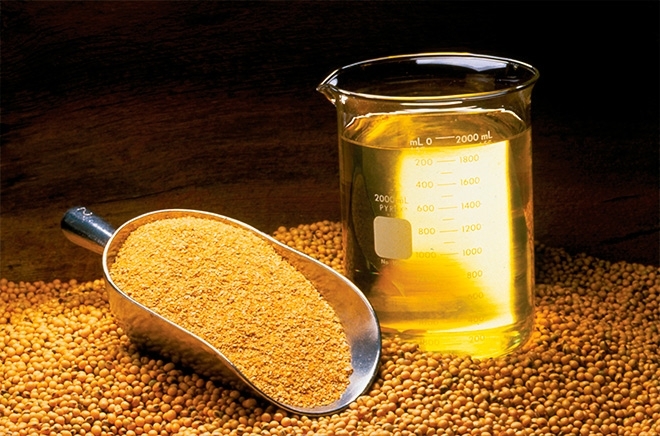

Researchers seek genetic markers as a basis for increasing oleic acid content of soybean oil via genomic selection; development is beneficial to human health and biodiesel production (photo: United Soybean Board / Wikimedia)
Researchers seek genetic markers as a basis for increasing oleic acid content of soybean oil via genomic selection; development is beneficial to human health and biodiesel production.
Researchers seek genetic markers as a basis for increasing oleic acid content of soybean oil via genomic selection; development is beneficial to human health and biodiesel production.

Researchers seek genetic markers as a basis for increasing oleic acid content of soybean oil via genomic selection; development is beneficial to human health and biodiesel production (photo: United Soybean Board / Wikimedia)
By Karina Toledo, in Campos do Jordão (Brazil) | Agência FAPESP – One of the reasons olive oil has become known as “the ultimate healthy fat” is its high oleic acid content: up to 84% of its total fatty acid content. Also known as omega 9, oleic acid is a monounsaturated fatty acid to which anti-inflammatory properties have been attributed, as well as the capacity to reduce “bad” (LDL) cholesterol.
Soybean oil also contains this nutrient, but in smaller amounts: 23% of total fatty acids on average. The proportion could become significantly higher in the future, thanks to the efforts of researchers at Santa Cecília University (Unisanta) in Santos, as well as the University of São Paulo’s Luiz de Queiroz College of Agriculture (ESALQ-USP) in Piracicaba, São Paulo State.
“Increasing the oleic acid content of soybean oil would be beneficial not only for human consumption but also for biodiesel production,” said Regina Priolli, a professor at Unisanta. “For this reason, our project seeks genetic markers that will let us modify soybean oil’s fatty acid profile by means of genomic selection.”
The investigation is supported by FAPESP and conducted under the aegis of the FAPESP Bioenergy Research Program (BIOEN). Recent results were presented during the third edition of the Brazilian BioEnergy Science & Technology Conference (BBEST), held in Campos do Jordão, Brazil.
Priolli explained that soybean oil contains four other fatty acids in addition to oleic acid. Palmitic acid (11% on average) and stearic acid (4%) are saturated fats, considered bad for the cardiovascular system. Linoleic acid, or omega 6, at 54% and linolenic acid, or omega 3, are polyunsaturated fats, considered healthy and associated with the flavor of soybean oil.
“Through genetic improvement, we can reduce the proportion of palmitic acid and increase that of oleic acid, for example,” Priolli said. “However, it’s important to find the right balance. If these fatty acids were present in the wrong proportions, the oil would harden at low temperatures.”
Genome mapping
The group led by Priolli set out to find the regions of the soybean genome that control the production of the five fatty acids found in the plant by means of a genome-wide association study (GWAS).
They first looked in germplasm banks – platforms dedicated to preserving the essential genetic material of species – in Brazil and elsewhere, locating material from 96 different accessions (lineages) with total oil content ranging from 10% to 30%.
“The genetic material for this kind of analysis has to be as diverse as possible, so we included 56 accessions from germplasm collection banks held overseas,” Priolli explained. “The term accession refers to each individual of a species registered with the germplasm bank. It can be a selected cultivar or a non-breeding lineage.”
During Priolli’s postdoctoral research, the plants were grown for two years at ESALQ-USP and then harvested. The researchers analyzed the oil content and fatty acid profile of each of the 96 accessions using gas chromatography.
The next step was to compare the data obtained in the field with molecular markers such as single-nucleotide polymorphisms (SNPs). The analysis revealed 54 SNPs associated with the synthesis of palmitic acid, 14 SNPs for oleic acid, 2 SNPs for linoleic acid, and 2 SNPs associated with the grain’s total oil content.
“After this mapping exercise, we compared the results with data from public soybean genome banks,” Priolli said. “Our aim was to see if the markers we found were close to some gene or had already had an association with oleic acid described.”
According to Priolli, besides aiming to change soybean’s fatty acid profile, the project is also designed to increase its total oil content. However, conventional plant-breeding techniques have shown that any increase in the oil content beyond the usual 20% reduces the amount of protein below normal levels, which average 40%, and this is not desirable.
“Soybeans are one of the world’s main sources of protein. The negative correlation between these two nutrients in soybeans makes it hard to increase both simultaneously. For this reason, modulating the fatty acid composition of soybean oil could be the best way to improve the quality of this staple,” Priolli said.
Republish
The Agency FAPESP licenses news via Creative Commons (CC-BY-NC-ND) so that they can be republished free of charge and in a simple way by other digital or printed vehicles. Agência FAPESP must be credited as the source of the content being republished and the name of the reporter (if any) must be attributed. Using the HMTL button below allows compliance with these rules, detailed in Digital Republishing Policy FAPESP.




